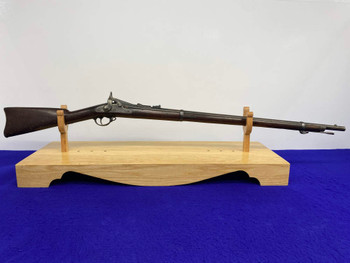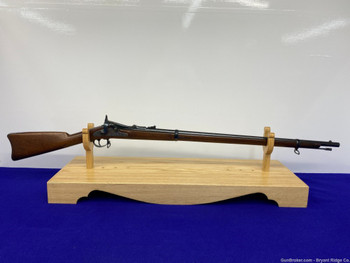Description
Item Description
Bryant Ridge Co. is pleased to present this collectible trapdoor single-shot rifle today for a penny-start auction, this is the Springfield Armory Model 1866!
SPECIFICATIONS:
Manufacturer: Springfield Armory
Model: 1866
Serial: No Serial
Caliber: .50-70
Finish: Blue
Barrel Length: 32 5/8"
Optics/Sights: Blade Front with Flip-Up Rear
Stock/Grips: Smooth Walnut
Action: Trapdoor / Single-Shot
Markings: Standard / The left side of the lockplate is stamped and dated “1863”, along with an Eagle and “U.S. Springfield”. The top of the breechblock is stamped “1866”. The top of the buttplate is stamped “U.S.”.
Bryant Ridge's Analysis:
During the U.S. Civil War, the advantages of breech-loading rifles became increasingly apparent. The standard infantry arm of the conflict—the rifled musket—could generally be fired at a rate of only two to three rounds per minute, and soldiers had to reload while standing, exposing themselves to enemy fire. By contrast, breech-loading arms such as the Sharps and Spencer carbines, though issued in limited numbers, could be fired much more rapidly—up to eight to ten rounds per minute in skilled hands—and reloaded from a prone or covered position, reducing vulnerability. As the war drew to a close, the U.S. Ordnance Department began evaluating various breech-loading systems for possible general adoption. Erskine S. Allin, Master Armorer at the Springfield Armory, devised a “trapdoor” breech mechanism that converted existing muzzle-loading muskets into breechloaders. His design appealed to the Army because of its relative simplicity and because it allowed economical reuse of the huge stockpile of Springfield Model 1863 rifled muskets.
Model: 1866
Serial: No Serial
Caliber: .50-70
Finish: Blue
Barrel Length: 32 5/8"
Optics/Sights: Blade Front with Flip-Up Rear
Stock/Grips: Smooth Walnut
Action: Trapdoor / Single-Shot
Markings: Standard / The left side of the lockplate is stamped and dated “1863”, along with an Eagle and “U.S. Springfield”. The top of the breechblock is stamped “1866”. The top of the buttplate is stamped “U.S.”.
Bryant Ridge's Analysis:
During the U.S. Civil War, the advantages of breech-loading rifles became increasingly apparent. The standard infantry arm of the conflict—the rifled musket—could generally be fired at a rate of only two to three rounds per minute, and soldiers had to reload while standing, exposing themselves to enemy fire. By contrast, breech-loading arms such as the Sharps and Spencer carbines, though issued in limited numbers, could be fired much more rapidly—up to eight to ten rounds per minute in skilled hands—and reloaded from a prone or covered position, reducing vulnerability. As the war drew to a close, the U.S. Ordnance Department began evaluating various breech-loading systems for possible general adoption. Erskine S. Allin, Master Armorer at the Springfield Armory, devised a “trapdoor” breech mechanism that converted existing muzzle-loading muskets into breechloaders. His design appealed to the Army because of its relative simplicity and because it allowed economical reuse of the huge stockpile of Springfield Model 1863 rifled muskets.
Each conversion costs about $5—far cheaper than manufacturing entirely new rifles. Allin was granted U.S. Patent No. 49,959 on September 19, 1865. The first version to employ this system, the Springfield Model 1865, was chambered for the .58 rimfire cartridge. Innovative but problematic, it suffered from a fragile rack-and-pinion extractor, an overly complex breech mechanism with many small parts, and a rimfire cartridge that delivered only modest ballistic performance. Field tests revealed that the design, while promising, was too delicate for reliable service use. The Springfield Model 1866, introduced the following year, addressed many of these flaws. Its barrel was relined to .50 caliber to chamber the newly adopted .50-70 Government centerfire cartridge, which offered significantly improved range, accuracy, and reliability.
The extractor was simplified into a sturdier form—still imperfect, but far more serviceable than its predecessor. Official manuals even noted that, in the event of extractor failure, empty cases could be removed by hand or with a cleaning rod. The breechblock itself was strengthened and streamlined, reducing the number of fragile moving parts and improving long-term durability. Approximately 52,000 Model 1866 rifles were produced, with most being conversions of older muskets and a small number of newly manufactured rifles. The Model 1866 saw combat almost immediately in the Indian Wars, most notably at the Wagon Box Fight and Hayfield Fight of 1867, where relatively small detachments of U.S. troops armed with breechloaders successfully held off large numbers of Lakota and Cheyenne warriors.
These engagements underscored the tactical value of breech-loading rifles in frontier warfare. In retrospect, the Springfield Model 1866 was a pivotal transitional firearm. It bridged the gap between Civil War–era muzzle-loading muskets and the definitive U.S. breech-loading service rifle, the Springfield Model 1873 “Trapdoor,” the first standardized purpose-built breechloader adopted by the Army. By combining cost-effective conversions with meaningful improvements in firepower, the Model 1866 marked a critical step in the modernization of U.S. military small arms in the late 19th century.
Return Policy:
We gladly offer a 3 day unfired inspection policy from the time that the firearm is delivered to your FFL. Refunds are available for all qualifying orders.
Shipping Details
Handgun Standard Shipping with Insurance $50.00
Long Gun Standard Shipping with Insurance $70.00
Any orders placed with magazines that are not compliant with your state, county, or city regulations will not ship with your order.
We strive to ship orders within the close of the following business day after payment and documentation is received.
Payment Details
We accept all forms of Payment including Personal Check, Business Check, PO Money Orders, Certified Check, Etc.
Please note we place a 7 business day hold on shipment, for all non-certified payments.
Payment MUST be received within 14 days.
Return Policy
We gladly offer a 3 day unfired inspection policy from the time that the firearm is delivered to your FFL. Refunds are available for all qualifying orders.
Additional Details
Our #1 priority is customer satisfaction. We want to build a lasting trust in the relationship with our customers, so that you will always look to us for all your firearms needs. If you have any issues with your transactions please contact us, and we will work with you to resolve any issues you may have. We greatly appreciate your trust in us and we look forward to fulfilling all your future firearm needs.
Bryant Ridge also reserves the right to cancel any sales that may occur while gunbroker.com is experiencing technical issues that affects the entire site or a complete site outage, within an hour of the auction ending.
We have an amazing inventory of classic and collector firearms that we are adding to Gunbroker daily. Stay up to date on all of our latest auction by adding us to your favorite sellers list.




















